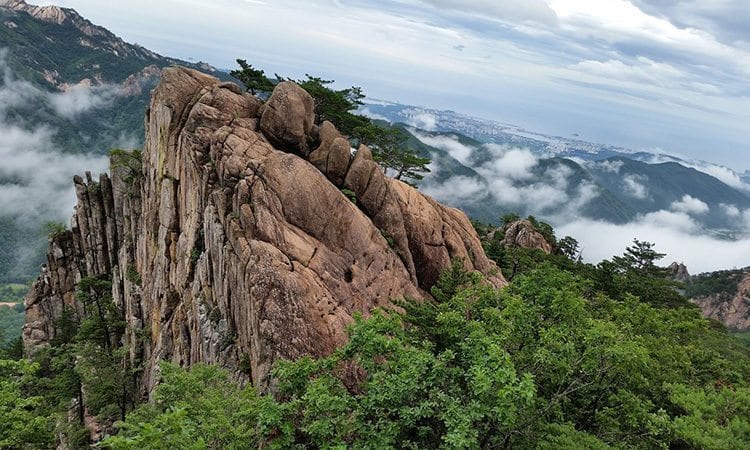Seoraksan National Park is generally considered to be South Korea’s greatest mountain playground, and its reputation is well-deserved. Situated in the far northeast corner of the country, just 50 kms from its sister range of Geumgangsan in North Korea, the ridges and peaks of Seoraksan command sweeping views of the East Sea (Sea of Japan).
But the wider, wilder views are of Seoraksan’s cathedral spire peaks and, beyond these, fading into the distance, Korea’s inland sea of hills and mountains.
While the pastime of hiking is only a few decades old in Korea, it has become so popular – especially in the fall – that the crowding can sometimes overwhelm the foreign visitor.
This is no reason to shy away from the mountains, though. It is possible to beat the crowds to partake in everything from autumn leaf-viewing expeditions to ambitious multi-day hikes – even in a park as popular as Seoraksan.
When to Go
If at all possible, try to visit the national park on a week day as the crowds thin out to just a fraction of the weekend volume. For anyone who has a steady job to hold down, however, weekend excursions may be the only option.
In this case, it is possible to find quietude and serenity by choosing less traveled courses. Starting from the park office at Sogongwon, rather than from the lesser visited side of the park (at Baekdam Temple for instance) is a bit like visiting the Great Wall of China at the mad tourist circus of Badaling instead of the atmospheric, awe-inspiring section at Simatai.
On the Mountain
Seoraksan Park offers plenty of day-hiking opportunities, but for the full experience, try to spend the night near the top. Of the five shelters, Jungchung and Sochung are closest to the highest peak, Daechungbong (Big Blue Peak), at 1708 meters (5,604 ft).
With an early rise, it’s only a 15-30 minute haul to the top, where you can watch the sun crack through the sea horizon, or melt through the clouds (weather permitting).
Note that the shelters are often booked up on the weekends; otherwise, their doors open to guests at 4 p.m. Basic food and drink are sold at the shelters (ramen tastes much better at this altitude!) and a berth costs W 8,000. Blanket rentals are W 1,000 a piece.
Finicky sleepers may want to bring earplugs, as many of your fellow hikers will rise at 4:30 a.m. Other necessary luxuries may include an inflatable pillow and a foam sleeping roll.
The Routes
Visitors looking to go on a short jaunt may consider the two hour course to Ulsanbawi the famous balancing boulder – and back. If you’d like to experience the view without the sweat, opt for the cable car ride near the park office.
Otherwise, aim for Biseondae. Most excursionists go no further than the branching off point of this streamside valley wedged between naked, vertiginous cliffs. Admire the ancient graffiti carved into the rocks or try a bowl of mountain vegetable (sanchae) bibimbap, washed down with any of a dozen herbal alcohols.
This is also the place to come for rock climbing and Buddhist fanaticism (pilgrims brave the seemingly endless, almost-vertical stairs up to Geumgang Grotto).
Glory seekers may want to consider starting from the hot spring resort town of Osaek (with local bus service from Sokcho). Osaek offers the shortest route to the top and back, doable as a day hike.
Serious hikers with a bit more time to spare and keen to avoid the crowds may start from Baekdamsa (Hundred Ponds Temple), one of the most important temples in Korea. The route to Oseh Hermitage offers a series of hardcore ups and downs while, further up, the Bongjung Hermitage may well be the best temple real estate in the country.
Just above the hermitage, the Sari Pagoda offers good photo opportunities so long as you don’t stand too close to the edge. Also while at the hermitage be sure to identify Buddha’s face in profile along the rocky edge of Sukgabong.
The most remote, and one of the most satisfying, of the Seoraksan courses is the long stretch in Outer Seorak starting from Namgyori. The emerald green pools (where mountain nymphs are said to have bathed) and waterfalls along this route are on par with the legendary scenery of Geumgangsan. Further into the park, along the Northwest Ridge, are a wild series of boulder fields where a single misstep could lead to an emergency airlift.
Among those hiking in Inner Seorak, brazen masochists should consider the course through Madeungnyung (“The Dinosaur’s Back”). Be prepared to scramble up and down rock walls and innumerable ladders; also be prepared to start the process all over again each time you make it to the top of another sharp peak.
Going Solo
Even if you can’t find any hiking buddies, you may still want to consider a solo trip as it’s a great way to meet Korean hikers. Most likely you’ll be invited to take part in a high altitude samgyeopsal dinner, or perhaps even a spam soup breakfast.
Be prepared for soju shots, and consider that these may improve the shelter’s sleeping conditions. Please try not to exploit the mountain hospitality, though – have some food on hand to contribute to the communal repast.
Getting There
For remoter, less crowded hiking in Outer Seorak (the western side), inter-city bus service is available to the small town of Wontang, or to the city of Inje. Tickets to Wontang and Inje from Seoul’s East Bus Terminal are also much cheaper than service to Sokcho.
The most popular starting point, from the main park office, is easily accessible by local bus from Sokcho. From Seoul to Sokcho, use the Gangnam Express Bus Terminal or your local Express Bus Terminal (See the Newcomer’s Directory on page 40 for resources on bus service nationwide).




